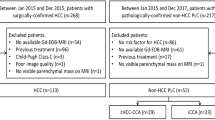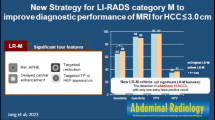Abstract
Objectives
To evaluate how sarcomatoid carcinomas (SCs) would be classified on magnetic resonance imaging (MRI) by using the Liver Imaging Reporting and Data System (LI-RADS) and to assess imaging features of SC compared with other hepatic malignancies.
Methods
We retrieved 184 patients with pathologically confirmed SC (n = 46), hepatocellular carcinoma (HCC, n = 92), and intrahepatic cholangiocarcinoma (iCCA, n = 46) diagnosed between January 2006 and December 2017. Two readers independently reviewed MRI according to LI-RADS v2017. Classification rate of SC, as probably or definitely malignant but not specific for HCC (LR-M), was calculated. LR-TIV (tumor in vein) was subclassified as either 5V or MV. MRI features were compared between SC, HCC, and iCCA and between SC of LR-M and non-LR-M categories.
Results
Chronic liver disease was present in 71.7% (33/46) of patients with SC, and LI-RADS was applied for these patients. SC was classified as LR-M in 24 (72.7%) of 33 patients at risk. SCs that had been classified as LR-4/5/5V were significantly smaller (median, 1.9 cm; range, 1.0–4.2 cm) than SCs classified as LR-M/MV (median, 4.3 cm; range, 1.3–20.6 cm) on independent t test (p = 0.012). SCs commonly showed MRI features similar to iCCAs than to HCCs. Targetoid appearance and capsular retraction were more frequent in iCCA than in SC (p ≤ 0.009) on Pearson’s chi-squared test or Fisher’s exact test.
Conclusion
Most SCs can be classified as LR-M on MRI, but small lesions may be indistinguishable from HCCs.
Key Points
• Most sarcomatoid carcinomas (SCs) are classified as LR-M on MRI by using LI-RADS v2017.
• SC showed various LR-M features similar to those of intrahepatic cholangiocarcinoma.
• Size of LR-4/5/5V SC was significantly smaller than that of LR-M/MV SC.





Similar content being viewed by others
Abbreviations
- CLD:
-
Chronic liver disease
- DWI:
-
Diffusion-weighted imaging
- HBP:
-
Hepatobiliary phase
- HCC:
-
Hepatocellular carcinoma
- iCCA:
-
Intrahepatic cholangiocarcinoma
- LI-RADS:
-
Liver Imaging Reporting and Data System
- MRI:
-
Magnetic resonance imaging
- SC:
-
Sarcomatoid carcinoma
- T1WI:
-
T1-weighted imaging
- T2WI:
-
T2-weighted imaging
- TIV:
-
Tumor in vein
References
Kakizoe S, Kojiro M, Nakashima T (1987) Hepatocellular carcinoma with sarcomatous change. Clinicopathologic and immunohistochemical studies of 14 autopsy cases. Cancer 59:310–316
Giunchi F, Vasuri F, Baldin P, Rosini F, Corti B, D’Errico-Grigioni A (2013) Primary liver sarcomatous carcinoma: report of two cases and review of the literature. Pathol Res Pract 209:249–254
Fred TB, Fatima C, Ralph HH, Neil DT (2010) WHO classification of tumours of the digestive system. IARC press, Lyon
Nishi H, Taguchi K, Asayama Y et al (2003) Sarcomatous hepatocellular carcinoma: a special reference to ordinary hepatocellular carcinoma. J Gastroenterol Hepatol 18:415–423
Hwang S, Lee SG, Lee YJ et al (2008) Prognostic impact of sarcomatous change of hepatocellular carcinoma in patients undergoing liver resection and liver transplantation. J Gastrointest Surg 12:718–724
Kaibori M, Kawaguchi Y, Yokoigawa N et al (2003) Intrahepatic sarcomatoid cholangiocarcinoma. J Gastroenterol 38:1097–1101
Lu J, Xiong XZ, Li FY et al (2015) Prognostic significance of sarcomatous change in patients with hepatocellular carcinoma after surgical resection. Ann Surg Oncol 22(Suppl 3):S1048–S1056
Liao SH, Su TH, Jeng YM et al (2018) Clinical manifestations and outcomes of patients with sarcomatoid hepatocellular carcinoma. Hepatology. https://doi.org/10.1002/hep.30162
Gu KW, Kim YK, Min JH, Ha SY, Jeong WK (2017) Imaging features of hepatic sarcomatous carcinoma on computed tomography and gadoxetic acid-enhanced magnetic resonance imaging. Abdom Radiol (NY) 42:1424–1433
Koo HR, Park MS, Kim MJ et al (2008) Radiological and clinical features of sarcomatoid hepatocellular carcinoma in 11 cases. J Comput Assist Tomogr 32:745–749
Honda H, Hayashi T, Yoshida K et al (1996) Hepatocellular carcinoma with sarcomatous change: characteristic findings of two-phased incremental CT. Abdom Imaging 21:37–40
Bilgin M, Toprak H, Bilgin SS, Kondakci M, Balci C (2012) CT and MRI findings of sarcomatoid cholangiocarcinoma. Cancer Imaging 12:447–451
Chung YE, Park MS, Park YN et al (2009) Hepatocellular carcinoma variants: radiologic-pathologic correlation. AJR Am J Roentgenol 193:W7–W13
Shi D, Ma L, Zhao D et al (2018) Imaging and clinical features of primary hepatic sarcomatous carcinoma. Cancer Imaging 18:36
American College of Radiology. Liver imaging reporting and data system (LI-RADS). American College of Radiology. Web site. https://www.acr.org/Clinical-Resources/Reporting-and-Data-Systems/LI-RADS/CT-MRI-LI-RADS-v2017. Accessed June 1, 2017
Heimbach JK, Kulik LM, Finn RS et al (2018) AASLD guidelines for the treatment of hepatocellular carcinoma. Hepatology 67:358–380
European Association for the Study of the Liver (2018) EASL clinical practice guidelines: management of hepatocellular carcinoma. J Hepatol 69:182–236
Mitchell DG, Bruix J, Sherman M, Sirlin CB (2015) LI-RADS (liver imaging reporting and data system): summary, discussion, and consensus of the LI-RADS management working group and future directions. Hepatology 61:1056–1065
An C, Rhee H, Han K et al (2017) Added value of smooth hypointense rim in the hepatobiliary phase of gadoxetic acid-enhanced MRI in identifying tumour capsule and diagnosing hepatocellular carcinoma. Eur Radiol 27:2610–2618
Seo N, Kim DY, Choi JY (2017) Cross-sectional imaging of intrahepatic cholangiocarcinoma: development, growth, spread, and prognosis. AJR Am J Roentgenol 209:W64–w75
Ariizumi S, Kotera Y, Takahashi Y et al (2011) Mass-forming intrahepatic cholangiocarcinoma with marked enhancement on arterial-phase computed tomography reflects favorable surgical outcomes. J Surg Oncol 104:130–139
Kim SJ, Lee JM, Han JK, Kim KH, Lee JY, Choi BI (2007) Peripheral mass-forming cholangiocarcinoma in cirrhotic liver. AJR Am J Roentgenol 189:1428–1434
Joo I, Lee JM, Lee SM, Lee JS, Park JY, Han JK (2016) Diagnostic accuracy of liver imaging reporting and data system (LI-RADS) v2014 for intrahepatic mass-forming cholangiocarcinomas in patients with chronic liver disease on gadoxetic acid-enhanced MRI. J Magn Reson Imaging 44:1330–1338
Kim YY, An C, Kim S, Kim MJ (2018) Diagnostic accuracy of prospective application of the liver imaging reporting and data system (LI-RADS) in gadoxetate-enhanced MRI. Eur Radiol 28:2038–2046
Fraum TJ, Tsai R, Rohe E et al (2018) Differentiation of hepatocellular carcinoma from other hepatic malignancies in patients at risk: diagnostic performance of the liver imaging reporting and data system version 2014. Radiology 286:158–172
Acknowledgements
The authors thank Ha Yan Kim for her help with the statistical advice.
Funding
The authors state that this work has not received any funding.
Author information
Authors and Affiliations
Corresponding author
Ethics declarations
Guarantor
The scientific guarantor of this publication is Myeong-Jin Kim.
Conflict of interest
The authors of this manuscript declare no relationships with any companies whose products or services may be related to the subject matter of the article.
Statistics and biometry
Nieun Seo performed statistical analysis, who is one of the coauthors. Ha Yan Kim, Ph.D., who is a member of our biostatistics collaboration unit, Yonsei University College of Medicine, gave us advice on the statistical analysis.
Informed consent
Written informed consent was waived by the Institutional Review Board for this retrospective case-control study.
Ethical approval
Institutional Review Board approval was obtained.
Methodology
• retrospective
• diagnostic or prognostic study
• performed at one institution
Additional information
Publisher’s note
Springer Nature remains neutral with regard to jurisdictional claims in published maps and institutional affiliations.
Rights and permissions
About this article
Cite this article
Seo, N., Kim, MJ. & Rhee, H. Hepatic sarcomatoid carcinoma: magnetic resonance imaging evaluation by using the liver imaging reporting and data system. Eur Radiol 29, 3761–3771 (2019). https://doi.org/10.1007/s00330-019-06052-8
Received:
Revised:
Accepted:
Published:
Issue Date:
DOI: https://doi.org/10.1007/s00330-019-06052-8




